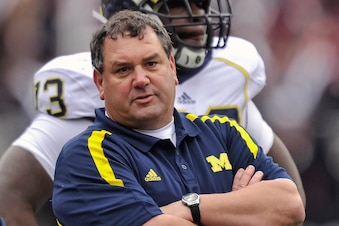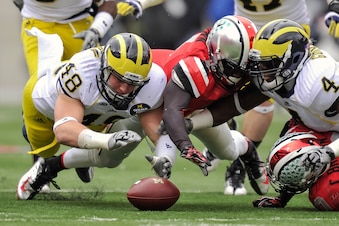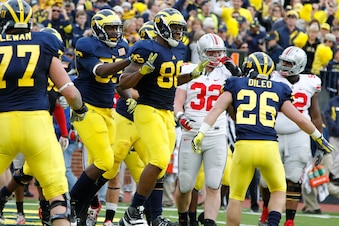 Jamie Sabau/Getty Images
Jamie Sabau/Getty Images
- Back to Home »
- Why Ohio State vs. Michigan Is the Best Rivalry in College Football
Sunday, December 1, 2013
 Jamie Sabau/Getty Images
Jamie Sabau/Getty Images
Regardless of where your alma mater sits in the landscape of college football, there will always be one or two teams that are the natural rivals. These are the teams to hate, while also doling out an equal measure of respect for the other side.
That's exactly what makes rivalries such a unique condition of the psychology known as "fandom." The competition, the pageantry, and the bragging rights all come together to make a memorable moment (or two) every single year for all college football teams.
But there is one rivalry that stands above them all. That rivalry is Ohio State vs. Michigan.
Or, as we call it in B1G country, The Game.
There are a number of reasons for OSU and UM to be standing atop the world when it comes to college football rivalries. Here are just a few, to go with the stuffing and sweet potatoes on your Thanksgiving and rivalry weekend.
Geographic Proximity = Rivalry
 Jamie Sabau/Getty Images
Jamie Sabau/Getty Images
The closer two schools are to each other geographically, the more likely that recruits will be poached from each other and the more likely that the fan bases will overlap in key recruiting grounds.
Ohio State and Michigan share a border in a part of the country that remains somewhat significant for college football recruiting. While perhaps not the geographic closeness of in-state rivalries such as many others in the Big Ten (Indiana-Purdue, Illinois-Northwestern) or others down south (Alabama-Auburn, South Carolina-Clemson), a big state border provides plenty of crossover for fans and recruits.
The maxim "keep your friends close and your enemies closer" works well in the rivalry context. After all, how better to stab your rival in the back than to stay close enough to steal all the best talent in the region or state, at least when that talent can be convinced to come play at the rival school?
Some of the other major rivalries (Army-Navy, Notre Dame-USC) suffer from not having this geographic proximity.
In addition, Ohio State and Michigan are two of the largest universities in the U.S., which means the alumni bases of both schools span far and wide across this country and worldwide. Therefore, no matter which of these teams you root for, the rival fans are probably gathering just around the corner to cheer against your favorite team.
That makes The Game even more transcendent than some in-state rivalries where the schools are even more geographically close than Columbus is to Ann Arbor.
Series Competitiveness = Rivalry
 Jamie Sabau/Getty Images
Jamie Sabau/Getty Images
Where does this mentality come from? That answer is simple: it typically comes from a discrepancy in the series history. The reason "Little Brother" exists is because that team struggles to beat "Big Brother" on a consistent basis.
The wins for the smaller or less historic school are memorable, but the competitive disadvantage takes away from the magic of the rivalry. A well-balanced pair of rivals never knows exactly what the outcome will be, which makes the wins all the more sweet and the defeats all the more bitter.
Plus, the competitiveness also leads to the ability for upsets on a regular basis. If there's anything college football fans love, it is the upset.
Ohio State and Michigan currently stand at 58-45-6 in the series, with Michigan leading. Even discounting the one game from 2010 that OSU had to vacate, that is only a 14-game spread over 108 eligible games.
That is incredible competitive balance.
The statistic becomes even more impressive when considering the last 25 years, where the series is all tied up 12-12-1. Michigan also won the first 13 games of the series before Ohio State got up to speed with the historic Wolverine program, which means the series is tied 45-45-4 over the last 94 meetings.
It does not get more competitive than that.
Here are some of the other top rivalries in the Big Ten and nationally (currently being played), and how they stack up:
- Alabama vs. Auburn: 42-34-1
- Florida vs. Florida State: 34-21-2
- Clemson vs. South Carolina: 65-41-4
- Oregon vs. Oregon State: 64-46-10
- USC vs. UCLA: 46-29-7
- Oklahoma vs. Oklahoma State: 83-17-7
- Texas vs. Oklahoma: 60-43-5
- Michigan vs. Michigan State: 68-33-5
- Minnesota vs. Wisconsin: 58-57-8 (closest that could be found with this much history)
- Alabama vs. Tennessee: 50-38-7
- Notre Dame vs. USC: 45-35-5
- Virginia Tech vs. Virginia: 52-37-5
- Mississippi vs. Mississippi State: 61-43-6
- Purdue vs. Indiana: 72-37-6
One interesting takeaway from the list above is that in-state rivalries are not generally as competitive as other rivalries, which may be caused by each state really being able to only support one football program at a top level over decades.
Nonetheless, the competitiveness makes for a rivalry, and there is plenty of competitive balance in The Game.
Program History = Rivalry
 Jamie Sabau/Getty Images
Jamie Sabau/Getty Images
However, there are not a ton of rivalries among these top programs. In all, 11 football teams have 800 wins historically: Michigan, Yale, Texas, Notre Dame, Nebraska, Ohio State, Oklahoma, Harvard, Alabama, Penn and Tennessee.
Discounting the Ivy League teams, that leaves only eight programs to consider for these top historical rivalries. Out of those remaining teams, here is the list of rivalries with a significant amount of games:
- Michigan vs. Ohio State: 109 meetings
- Michigan vs. Notre Dame: 41 meetings (but inactive after 2013)
- Texas vs. Oklahoma: 108 meetings
- Nebraska vs. Oklahoma: 86 meetings (inactive since 2010)
- Alabama vs. Tennessee: 95 meetings
So outside of the Red River Rivalry and the "Third Saturday in October" rivalry in the SEC, there is no other rivalry that comes close to The Game for number of meetings between historically dominant programs. It means something when Texas and Oklahoma hit the field together, just like when Michigan and Ohio State step on the same field this weekend.
The Game is beginning to separate itself from the pack of rivalries, including the Iron Bowl.
Crazy Men and Traditions = Rivalry
 Jamie Sabau/Getty Images
Jamie Sabau/Getty Images
One of the most storied coaches in college football, Woody Hayes, refused to refer to Michigan by name, preferring the moniker "That School Up North." Brady Hoke has now accepted this same challenge and never refers to OSU as "Ohio State," instead using the moniker "Ohio."
The governor of the state of Ohio, John Kasich, decided to ban use of the letter "M" this week in Ohio. This is just pure ridiculousness; all based on a football rivalry!
Ohio State students jump into a freezing cold lake full of duck poop every year during Michigan week. There are competitive blood drives between the schools on the week of the rivalry. Michigan students make a pilgrimage to a local cemetery to lay flowers at the grave sites of three great former Michigan coaches.
There are also more bouts of crazy in the history of this rivalry. When Ohio State and Michigan tied in 1973 and a secret vote of athletic directors decided who would go to the Rose Bowl that season (OSU), the controversy and bad blood boiled over and remains to this day.
Plus, this rivalry started with bad blood based on a short-lived war between these states called the Toledo War. Not many rivalries have a level of crazy built in from an actual civil war!
Kansas and Missouri is one of the few others, but it is not active now that Missouri is in the SEC.
While rivalry traditions and crazy events could be pulled up for every big game (the poisoning of the trees in Alabama-Auburn is another recent top moment of crazy), Ohio State and Michigan could certainly compete with the best in this field.
Big Stakes = Rivalry
 Gregory Shamus/Getty Images
Gregory Shamus/Getty Images
Just take one look at the budding rivalry between Wisconsin and Ohio State to understand this phenomenon. A better example is the more well-established rivalry between LSU and Alabama, which has had huge stakes the past few seasons.
Ohio State and Michigan routinely play for these large stakes. At least one of the two teams is typically competing for a conference championship, if not a national championship.
The highlight of this was in 2006, when the teams were ranked No. 1 and No. 2 nationally and both were undefeated heading into The Game. That day, Ohio State won a chance to play for a BCS Championship as well as the Big Ten title and bragging rights.
Those are stakes that draw the entire country's attention.
Between the teams, there are 18 national titles and 76 Big Ten championships. No other team in the conference has more than 15 Big Ten titles, which means generally one or both of these programs has the hardware on the line in this season finale.
2013 is yet another example of this, as Ohio State is heading into a Big Ten Championship game and is trying to avoid having a season spoiled by Michigan. One only has to ask the Buckeye teams of 1993, 1995 and 1996 how it feels to have a dream season ruined in The Game.
Of course, all eyes are on the Iron Bowl this year as Auburn and Alabama meet with both teams playing for a SEC title and both teams ranked in the top 5 for the first time ever.
Those are the types of high stakes that make rivalries grand, but the Iron Bowl cannot boast the amount of meetings with those high stakes on the line that The Game can.
Thus, while every rivalry is one to enjoy and savor each college football season, Michigan and Ohio State stand above the rest.
Brawling = Rivalry
Michigan and Ohio State are good at brawling. Here's just a few examples, including a link to the 2013 edition of The Brawl (which led to three ejections).
2013 game brawl video: See here.










